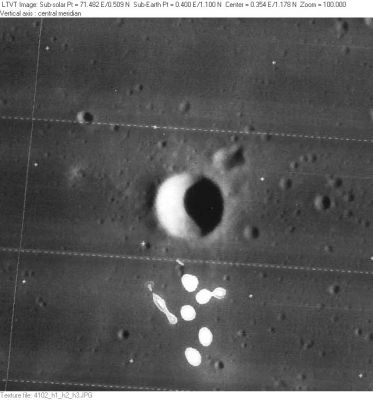Bruce
Contents
Bruce
|
Lat: 1.1°N, Long: 0.4°E, Diam: 6 km, Depth: 1.27 km, Rükl: 33 |
Images
LPOD Photo Gallery Lunar Orbiter Images Apollo Images
- Four west-looking oblique Hasselblad frames on color film, made during the mission of Apollo 10, show Bruce in Sinus Medii at local sunrise (local morning light). These four frames are:
AS10-27-3905 (appearing together with nearby Blagg, and Rhaeticus L near the frame's lower margin)
AS10-27-3906 (appearing together with nearby Blagg, sunrise terminator in the distance)
AS10-27-3907 (Bruce near the frame's lower margin, sunrise terminator in the distance)
AS10-27-3908 (Bruce near the frame's lower-right corner)(somewhere near the centre of this frame there's also the impact site of Surveyor 4 and nearby landing site of Surveyor 6).
Note that these four frames were frequently reproduced (printed) in popular books of manned spaceflight and pre-Apollo 11 literature.
Research Apollo 10 photographs: Danny Caes
Maps
(LAC zone 59C4) LAC map Geologic map AIC map
Description
Description: Wikipedia
Additional Information
- Depth data from Kurt Fisher database
- Arthur, 1974: 1.27 km
- Westfall, 2000: 1.27 km
- Viscardy, 1985: 1.3 km
- Included in ALPO list of bright ray craters
- Bruce and Oppolzer A are the nearest (telescopically observable) craters to the moon's "centre" (0° Longitude/ 0° Latitude). The couple of bowl-shaped craters Bruce and Blagg (both in Sinus Medii) are easy to observe through common telescopes. The much smaller Oppolzer A (immediately north of the ruined crater Oppolzer) is a much more difficult target.
- Both Surveyor 4 and Surveyor 6 impacted/ landed about 60 kilometers west of Bruce and Oppolzer A (see: chart 33 in Antonin Rukl's Atlas of the Moon).
Nomenclature
- Named for Catherine Wolfe Bruce (January 22, 1816 - March 13, 1900), a noted American philanthropist and patroness of astronomy. Between 1889 and 1899 she donated money for purchases of telescopes by Harvard College Observatory, Yerkes Observatory and by Max Wolf of Landessternwarte Heidelberg-Königstuhl, among others. The Bruce Medal and the asteroid 323 Brucia (named by Wolf) are named in her honor.
- According to Whitaker (p. 226), the name Miss Bruce was introduced by Krieger and König. It entered the IAU nomenclature as plain Bruce in Named Lunar Formations (1935).
- Julius Schmidt had previously suggested the name Birt for this crater, but that named was used for a different feature.
- List of features named for women.
- The name Bruce should not be confused with the NASA-related name Cape Bruce (the hook-shaped peninsula northwest of Censorinus). - DannyCaes Jan 10, 2016
LPOD Articles
Bibliography
